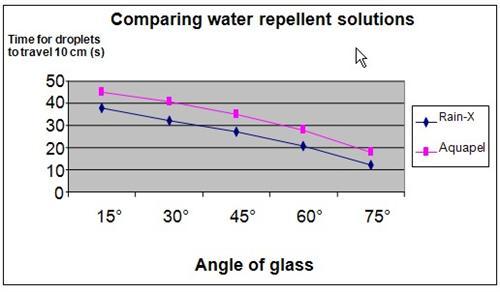| Complexity level: | 7 |
| Project cost ($): | 80 |
| Time required: | 1 hour to prepare, 1 hour for the science project experiment |
| Material availability: | Easily found |
| Safety concerns: | Handle glass carefully - wear protective gloves |
Hypothesis
Car windscreens with Rain-X are able to repel water better.
Overview
Glass and water repellents
Glass is a very special material but when it is viewed under a microscope, plenty imperfections may be observed. The surface actually contains many pores which can easily trap contaminants, dirt and moisture.
Rain water mixes with brake dust, oil spills, rubber particles released from tyres and other types of dirt found on roads. When we drive along a road on rainy days, a lot of this dirt and contaminated water is splashed on to our windshields. Moreover, when you use your wipers, whilst water gets pushed off the glass, a heavy pressure is applied in the windshield by the wiper blades, causing dirt found on the glass to be forced into tiny surface pores.
The best solution for the problem is to coat the windshield with a water repellent material, which will also help to fill up these pores. The windshield then possesses water-repelling properties and any water on the surface will be seen to form into a “bead” shape. These droplets are easily blown off the windscreen, as the car moves forward at high speeds.
Scientific Terms
Materials
The materials required for our science fair project:
- 2 glass sheets (suggested size 20cm x 20cm) or plates
- 1 bottle of Rain-X
- 1 bottle of Aquapel
- 1 wooden block (40mm x 100mm x 200mm)
- 1 marker pen
- 1 eye-dropper
- 1 beaker of water
- 1 ruler
- 1 stopwatch
- 1 protractor
- 1 piece of cloth
Procedure
1. For this science fair project, the independent variable is the angle at which the glass is slanted and the brand of water repellent used. The dependent variable is the time taken by the water to flow 10 cm down the surface of the glass sheets. The constants (control variables) are the smoothness of the glass surface, the distance the water droplet travels and the room temperature.
2. Two glass sheets are marked “Rain-X” and “Aquapel” with the black marker pen. The water repellent solutions are wiped on the glass surface using a piece of cloth. The brand of the water repellent solution used on the glass surface should match with the marking.
3. Using the marker pen and a ruler, 2 lines 10cm apart are drawn on the 2 glass sheets. These 2 lines l represent the start and finish lines for the water droplet to travel.
4. The glass sheet marked Rain-X will be tested first. Using the wooden block and the protractor, the glass sheet is made to rest at a slanted position. The plate will be slanted at 15 degrees to the table surface. The angle will be confirmed using a protractor. The 2 lines drawn earlier should be horizontal to the table surface.
5. The eye-dropper is used to place a drop of water on the upper line of the glass surface. The stopwatch is started and the time taken by the droplet to travel to the bottom line is measured. The result is recorded in the table given below.
6. Procedures 4 and 5 are repeated at 30 degrees, 45 degrees, 60 degrees and 75 degrees. All the measured times are recorded in the table given below.
7. Procedures 4, 5 and 6 are repeated using the glass coated with Aquapel solution. All results are recorded in the table given below.

Results
It was observed that the water droplet on the glass coated with Rain-X traveled more quickly than the water droplet on the glass coated with Aquapel.
|
Water repellent solution |
Time taken by water drop to travel 10cm(seconds) |
||||
|
15° |
30° |
45° |
60° |
75° |
|
|
Rain-X |
38 |
32 |
27 |
21 |
12 |
|
Aquapel |
45 |
41 |
35 |
28 |
18 |
The graph below represents the results of our science project experiment.

Conclusion
Our hypothesis has been proven correct. The hypothesis that car windscreens treated with Rain-X are able to repel water.
Using water repelling solutions on car windshields will help to keep the glass clean and clear on rainy days. These products can also help to reduce fogging and misting on the windshield. They help us to drive more comfortably and safer at night and on rainy days.
Also consider
Would your results differ if the science fair project were to be repeated by fixing the angle of slant of the glass and varying the speed of the wind?
The science fair project can also be repeated using different brands of water repellent like Rain Clear.
References
Rain-X versus PPG Aquapel- grudge match - http://www.sports.autoblog.com/2006/04/17/rain-x-versus-ppg-aquapel-grudge-match%20/
Rain-X - http://www.clean-image.co.uk/products/rainx.htm
Rain Clear rain repellent gel kit - http://www.properautocare.com/raclrare.html

